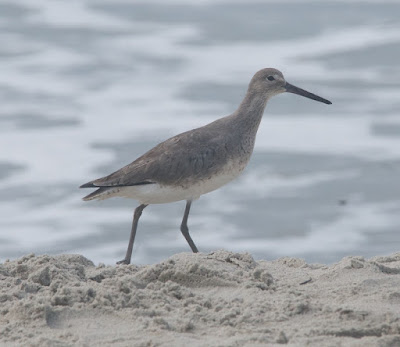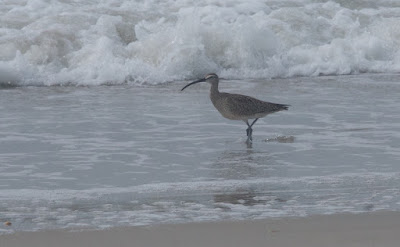One of the odder sights on the beach is a tiny museum devoted to the art of waterfowl carving.
Various local carvers take turns displaying their craft inside an old beach house.
The results (many of which are for sale) range from functional decoys to an attractively-carved Gadwall, obviously intended for a display shelf.
We spent a night in Morehead City, North Carolina, and drove out the next morning onto the most southerly of the Outer Banks islands, dominated by the resort community of Emerald Isle. Much of the Atlantic side of the island is private property, but there are some really beautiful public beaches, almost empty of people this early in the year. This is the beach at Pine Knoll Shores.
A stroll on the beach gave me a chance to do a bit of birding.
Laughing Gulls (Leucophaeus atricilla) dominate the beach, as they do along much of the eastern seaboard. April is the courtship season for these gulls, and this pair seem to be in the throes of making (or renewing) acquaintances.
The Willet (Tringa semplalmata) is a year-round resident on southeastern beaches, nesting in the saltmarshes nearby.
It appears to be a particularly plain creature, but when it flies it reveals striking black-and-white wings. It’s not doing that here, of course.
Paths crossing on the beach: a Laughing Gull and a Willet.
This Whimbrel (Numenius phaeopus), on the other hand, is undoubtedly just refueling here before heading north to its nesting grounds on the tundra.
I am far from the first to be convinced that Shakespeare had Sanderlings (Calidris alba) in mind when he had Prospero invoke “ye that on the sands with printless foot /Do chase the ebbing Neptune and do fly him / When he comes back”.
Sanderlings do that sort of thing as a matter of course. It is not a game; the ebbing waves may momentarily turn up small creatures living among the sand grains, and by chasing the waves the Sanderlings have a chance to snatch them up before they can burrow to safety.
Our next stop on our journey south was the boardwalk at Jones Island, NC, an attractive bit of coastal saltmarsh and evergreen forest, now mostly protected as part of Hammock Beach State Park.
I am always happy to see a well-labelled trail, especially one that identifies plants. Otherwise, how would I know that this is Black Needlerush (Juncus roemerianus), a plant valued for its ability to tolerate soil contaminated with diesel oil and other pollutants. It is a dominant species in the saltmarsh.
Blackberries (Rubus spp.) are attractive enough as flowers, but I confess I prefer them when they are in fruit!
The commonest honeysuckle in the Carolinas is probably the introduced (and extremely aggressive) Lonicera japonica, and that is, I suspect, what this is.
The boardwalk itself attracted a curious Northern Mockingbird (Mimus polyglottos)...
...and this rather striking American or American Bird Bird Grasshopper (Schistocerca americana), a common species that can be a serious agricultural pest.
Our route southward took us onward through South Carolina, but left little opportunity for nature-watching except for a bit of a morning poke-around at the edge of a saltmarsh behind our hotel in Beaufort, in the state’s southeastern corner.
Though we were a few miles from the open ocean there were still crabs here, scuttling underfoot as I scrambled about trying to photograph them. This, of course, is a male Fiddler Crab, probably either a Mud Fiddler (Uca pugnax) or a Red-jointed Fiddler (Uca minax).
These crabs, lacking the impressive 'fiddles' of the fiddlers, are Marsh Crabs (Sesarma reticulatum). This species has a rather odd ecological history: after humans overfished its major predators, it underwent a population explosion. Marsh Crabs are herbivores, and the exploded population proceeded to eat its way through large tracts of creekside and saltmarsh vegetation. To the rescue came, surprisingly, an exotic species, the Green Crab (Carcinus maenas), which both ate the Marsh Crabs and evicted them from their burrows - a rare case (though perhaps not as rare as we usually believe) of an invasive species becoming a key factor in restoring a native ecosystem.
By now we were in the Deep South, and for a naturalist one of the most obvious signs of that were the clumps of grey-green Spanish Moss (Tillandsia usneoides) festooned over the limbs of almost every tree in sight. Despite its name and appearance, Spanish Moss is a bromeliad, a relative of the pineapple.
Even more Spanish Moss, draped over the spreading limbs of Live Oaks (Quercus virginiana): a sure sign that we were now in the Deep South, in the historic center of Savannah, Georgia, not far from the Florida border.











































No comments:
Post a Comment